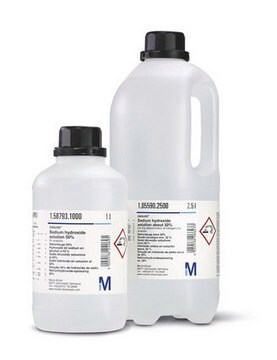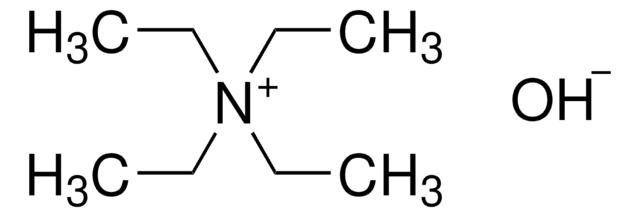1.08124
Tetramethylammonium hydroxide solution
c(C₄H₁₃NO)=0.1 mol/l (0.1 N) in 2-propanol/methanol, ready-to-use volumetric solution for titration in non-aqueous media, Titriplex®
About This Item
Polecane produkty
Nazwa produktu
Tetramethylammonium hydroxide solution, in 2-propanol/methanol for titrations in non-aqueous media c(C4H13NO)=0.1 mol/l (0.1 N), Titripur®
Poziom jakości
linia produktu
Titripur®
Formularz
liquid
jakość
Analyzed in our ISO 17025 accredited QC lab
przydatność reakcji
reaction type: Acid-base reactions
reaction type: Redox Reactions
stężenie
0.1 M
metody
titration: suitable
pH
14 (20 °C in H2O)
temp. przejścia
flash point 15 °C
gęstość
0.79 g/cm3 at 20 °C
temp. przechowywania
15-25°C
Powiązane kategorie
Zastosowanie
- An Approach Based on an Increased Bandpass for Enabling the Use of Internal Standards in Single Particle ICP-MS: Application to AuNPs Characterization.: This study by Bazo et al. (2023) explores the use of Tetramethylammonium hydroxide solution to enhance internal standard applications in single particle ICP-MS for gold nanoparticle characterization. This method improves accuracy and reliability in nanoparticle detection (Bazo et al., 2023).
- Titanium dioxide nanoparticles assessment in seaweeds by single particle inductively coupled plasma - Mass spectrometry.: López-Mayán et al. (2022) utilized Tetramethylammonium hydroxide solution for the assessment of titanium dioxide nanoparticles in seaweeds. This approach allows for precise quantification and analysis of nanoparticles in complex matrices (López-Mayán et al., 2022).
- Determination of selenite and selenomethionine in kefir grains by reversed-phase high-performance liquid chromatography-inductively coupled plasma-optical emission spectrometry.: Bodur et al. (2021) used Tetramethylammonium hydroxide solution to effectively separate and quantify selenite and selenomethionine in kefir grains, demonstrating its utility in food chemistry applications (Bodur et al., 2021).
- Application of TMAH thermochemolysis to the detection of nucleobases: Application to the MOMA and SAM space experiment.: He et al. (2019) applied Tetramethylammonium hydroxide solution in thermochemolysis for detecting nucleobases in space mission experiments, demonstrating its application in astrobiology and space chemistry (He et al., 2019).
Cechy i korzyści
This volumetric solution is analyzed by our calibration laboratory D-K-15185-01-00 which is accredited according to DIN EN ISO/IEC 17025 for analysis of amount-of-substance concentrations in volumetric solutions by DAkkS (Deutsche Akkreditierungsstelle - German National Accreditation Body). The accreditation certificate can be found at www.sigmaaldrich.com/ISO17025.
Komentarz do analizy
Amount-of-substance concentration 0.0994 - 1.006 mol/L
Measurement uncertainty ± 0.0004 mol/L
Traceability NIST SRM
The concentration is determined by volumetric titration and refers to 20°C.
The amount-of-substance concentration of this volumetric solution is traceable to a primary standard reference material (SRM) from the National Institute of Standards and Technology, Gaithersburg, USA (NIST SRM 350 benzoic acid) by means of volumetric standard benzoic acid (article number 1.02401), certified reference material according to ISO 17034, analyzed by our accredited calibration laboratory of Merck KGaA, Darmstadt, Germany according to DIN EN ISO/IEC 17025. The uncertainty is expressed as expanded measurement uncertainty with a coverage factor k=2 covering a confidence level of 95%.
Note: The titer is a correction factor to correct for variations of the volumetric solution, the titration equipment, the temperature and other laboratory conditions. For correct titration results it is recommended to determine a titer with the laboratory specific equipment and under laboratory specific conditions directly after opening a new bottle and at regular time intervals.
Informacje prawne
produkt powiązany
Hasło ostrzegawcze
Danger
Zwroty wskazujące rodzaj zagrożenia
Zwroty wskazujące środki ostrożności
Klasyfikacja zagrożeń
Acute Tox. 3 Dermal - Acute Tox. 3 Oral - Acute Tox. 4 Inhalation - Eye Dam. 1 - Flam. Liq. 2 - Skin Corr. 1 - STOT RE 2 Dermal - STOT SE 1 - STOT SE 3
Organy docelowe
Central nervous system
Kod klasy składowania
3 - Flammable liquids
Klasa zagrożenia wodnego (WGK)
WGK 2
Temperatura zapłonu (°F)
59.0 °F
Temperatura zapłonu (°C)
15 °C
Wykazy regulacyjne
Wykazy regulacyjne dotyczą głównie produktów chemicznych. Można w nich podawać ograniczoną liczbę informacji na temat produktów niechemicznych. Brak wpisu oznacza, że żaden ze składników nie znajduje się w wykazie. Użytkownik odpowiada za zagwarantowanie bezpiecznego i zgodnego z prawem stosowania produktu.
EU REACH Annex XVII (Restriction List)
Certyfikaty analizy (CoA)
Poszukaj Certyfikaty analizy (CoA), wpisując numer partii/serii produktów. Numery serii i partii można znaleźć na etykiecie produktu po słowach „seria” lub „partia”.
Masz już ten produkt?
Dokumenty związane z niedawno zakupionymi produktami zostały zamieszczone w Bibliotece dokumentów.
Klienci oglądali również te produkty
Nasz zespół naukowców ma doświadczenie we wszystkich obszarach badań, w tym w naukach przyrodniczych, materiałoznawstwie, syntezie chemicznej, chromatografii, analityce i wielu innych dziedzinach.
Skontaktuj się z zespołem ds. pomocy technicznej


![Tetra-n-butylammonium hydroxide solution in 2-propanol/methanol for titrations in nonaqueous media c[(C4H9)4NOH] = 0.1 mol/l (0.1 N), Titripur®, reag. USP](/deepweb/assets/sigmaaldrich/product/images/217/795/18cba546-7592-4bb4-8b67-0b4b229e0a2f/640/18cba546-7592-4bb4-8b67-0b4b229e0a2f.jpg)







